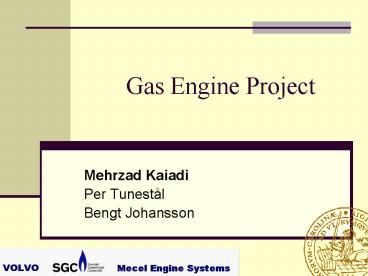Gas Engine Project PowerPoint PPT Presentation
1 / 41
Title: Gas Engine Project
1
Gas Engine Project
- Mehrzad Kaiadi
- Per Tunestål
- Bengt Johansson
2
Outline
- Project history
- Achieved Results from the Previous Work
- Present Project
- Test-Cell Status
- Initial Measurements
- Follow-On Program / Schedule Suggestions
3
Project History
- 1990Flame propagation and turbulence
- 1995Combustion chamber effect on turbulence,
combustion and emissions(single-cylinder engine
Volvo TD102) - 1997-2003Experiments on the multi-cylinder
engine (6 cyl. Volvo TG103)
Goals Improve Engine Stability, Efficiency
and Output Power Reduce Emissions
4
Achieved Results from previous Work
- Combustion chamber effect on turbulence and
combustion - Lean operation versus Stoichiometric operation
diluted with EGR
5
Achieved results (Turbulence)
Reentrant Square
Reentrant Cylindric
Fair Top
Nebula
Quartette
Turbine
6
Achieved results (Turbulence)
In-cylinder flow and heat release
7
Conclusions of the previous work
- Stoichiometric operation diluted with EGR is
recommended - Highly diluted mixtures have cold and slow
combustion - Quartette combustion chamber was designed to
generate high turbulence and speed up combustion
8
Present Project
- Will be based on the previous results New Ideas
- Stoichiometric operation diluted with EGR
9
Test Engine (Volvo 9.4 Liter)
10
New Features
- Multi Port fuel injection is designed (Single
point injection will be replaced by this) - Advantages
- Improved volumetric efficiency
- More uniform fuel distribution
- Rapid engine response to change throttle position
- Better control of lambda during cold-start
- Results in increasing power and torque
11
New Features
12
New Features
- New Ignition and Injection System is developed
- Cylinder-individual control of fuel injection
- Ion-current signals (will be available in near
future)
13
Established Engine Test-Cell
14
Established Engine Test-rig
15
Engine Control System
16
Engine Control System (Interface)
17
Running Method
- Stoichiometric operation diluted with EGR
- Impelementing HEDGE concept In order to achieve
diesel engines efficiency and otto engines
emissions level (Use high EGR rates coupled with
high energy ignition system)
18
Why HEDGE ???
- Diesel Engines
- High efficiency
- High emissions (Soot NOx)
- - Catalyst (Costly reduce efficiency)
- Gasoline Engines
- Reasonable emissions (By running
- Stoichiometric using 3way catalyst)
- Lower performance
- - Lower fuel economy
How to get diesel efficiency ?
High Efficiency diluted Gasoline Engine (Good
candidate) Reasonable emissions Air-flow boost
will increase the performance Highly diluted
with EGR can increase the knock limitations and
decrease NOx
19
HEDGE Structure
20
Initial Measurements
- Finding out
- lean limits (lambda EGR)
- Behavior of the engine (cylinder variation)
- EGR Vs. Lean
21
Initial Measurements
- 1200 RPM
- Constant air flow / variation of fuel flow
2 Reasons Big cylinder to cylinder variations
Not optimal combustion chamber (no turbulance)
22
Cylinder to Cylinder variation
23
Cylinder to Cylinder variation
24
Initial Results (Lean/EGR)
- Raw hydrocarbons, HC
Lean operation (?gt1)
EGR operation (?1)
25
Initial Results (Lean/EGR)
- Raw nitric oxides, NOX
Lean operation (?gt1)
EGR operation (?1)
26
Initial Results (Lean/EGR)
- Raw carbon monoxide, CO
Lean operation (?gt1)
EGR operation (?1)
27
Brake Efficiency
28
Learning from the first running
- New intake manifold should be designed
- Engine behaves in expected manner
29
Follow-on Program / Suggestion
- Modeling
- GT-Power Model of the engine
- Running Miller cycle
- Artificial Neural Networks (ANNs) Modeling
- Experiment
- Studying Closed-loop combustion control to
optimize the amount of fuel and EGR (by
controlling lambda and COVimep) - Studying the effect of cylinder variation
- Transient runnings
- Implementing ion current measurments
30
GT-Power Modeling
- Investigating Higher Performance Potentials
- SI engines have poor performance at part and
light loads - Miller cycle can be a solution
- VVT
- Supercharger
- since it needs extra components modeling is the
most cost-effective way
31
GT-Power Modeling
- The expansion ratio is greater than compression
- By allowing inlet valve be open for a longer time
- gt effective comprestion ratio decreases
- gt Better efficiency
- Excepted Results Higher efficiency at low loads
32
Closed-Loop Combustion Control
- Lambda Control For controlling the overall
air/fuel ratio - COVimep Control Since the engine is run with
high rate of EGR, the variation in mixture
composition especially near the spark plug can be
high and thereby the operation will be rough and
unstable
33
Closed-Loop Combustion Control
- Expected results Excellent steady-state
performance and limited transient performance
34
Studying the Effect of cylinder variation
- Why?
- Better understanding of cycle variations effect,
and how to control them - How?
- By changing ignition timing or / and lambda
(injection offset) of only one cylinder find out
how the other cylinders behave
35
Projects Time Schedule
36
ANNs Modeling (Suggestion)
- What is a Neural Network?
- Definition An Artificial Neural Network (ANN) is
a computer program that can recognize patterns in
a given collection of data and produce a model
for that. It resembles the brain in two ways - Learning from experience (trial and error)
- Interneuron connections known as weights are used
to store the knowledge
37
ANNs Structure
- Artificial Neuron
- An ANNs is a set of processing elements and
connections with adjustable weights
Inputs
Outputs
38
How dose an ANN work?
- Train the Network
- Present data into networks
- Network computes an output
- Network output compared to desired one
- Networks weights are modified to reduce the error
- Generalization to new data
- Use the Network
- Present new data into networks
- Networks compute an output based on its training
39
ANNs Applications
- Sensitivity analysis
- Tracking degradation
- Making a user-friendly interface of the engine in
e.g. Excel - Online-Monitoring / Using in control loops
40
Supervising ANN (online-monitoring)
- Early varning system
41
- Thanks for Your Attention!
- Questions?

